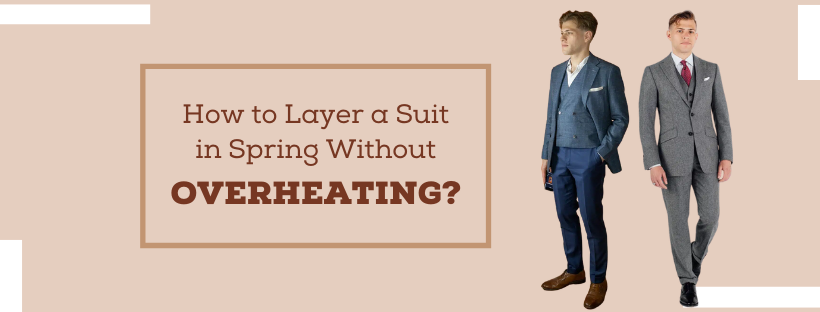
How to Layer a Suit in Spring Without Overheating?
While the spring temperatures can vary in the range of 30s to 60s, the layering primarily depends on your region. The northern states experience colder temperatures than the southern states. So, accordingly, men can alter their layering options.
Layering for a colder spring
- 3-layer principle
As the temperatures are colder, you need a three-layer suiting with a breathable and moisture-wicking base layer, an insulating middle layer, and a lightweight outer layer.
While the early spring can be more freezing with the winter transition, the three-layer can sometimes not suffice, and a four-layer can be chosen. However, as the temperature gradually increases, you can cut down the layers.
- Loose or relaxed fit layers
Irrespective of the layer—base, middle, or outer, ensure your layers are relaxed and do not have a slim fit. Wearing loose clothing can keep your body airy and ventilated. On the other hand, wearing slim-fit shirts or blazers in spring can build up heat and make you sweat more despite the colder weather.
- Breathable fabrics
Every layer in spring must be breathable, leaving more room for air circulation. Fabrics like linen and wool are the best choices for a colder spring. Particularly, a linen undershirt or dress shirt paired with a woolen sweater or cardigan makes the best layering for spring.
- An insulating layer
The insulating layer can be anything like a vest, cardigan, or blazer. When you wear an ordinary vest-type middle layer, you can choose a woolen jacket. Otherwise, you can go for a cardigan-type middle layer with an ordinary suit jacket or blazer. The choice is all yours!
- Lightweight layers
As we’re adding more layers for a colder spring, it is better to keep all of them light in weight so that you don’t feel heavy about your layers. Wearing one heavy layer can make you feel tired, heavy, and sticky. Thus, ensure every layer of your spring suit is made of lightweight fabrics and is breathable.
Layering for a warmer spring
Except for the number of layers, the rest of the colder spring layering options also work for warmer springs. In other words, the three-layer principle is reduced to a two-layer principle to accustom to warmer temperatures, and the rest remains the same—breathable fabrics, insulating layer (middle or outer layer), and lightweight layers.
Best men’s suit layering choices for spring
- A versatile beige suit
As light colors work better than dark colors in spring, it is always better to have one light-hued suit and matching trousers, like beige, ivory, or light stone. You can pair this suit with any contrasting dress shirt and create multiple spring looks with utmost elegance.
- A floral shirt to match any dark blazer
Of course, floral shirts are needless to mention! Having a light-hued floral shirt can help you style it with many solid suits.
- Seersucker—the attractive choice
Though linen and wool are the best choices, seer sucker can be counted for special occasions like an important event or occasion. It is a lightweight cotton fabric that is breathable and ventilating. Most importantly, it gives a new, stylish look, replacing your regular suiting style.
- The best fitting—tailored or made-to-measure
Standard-sized spring suits can either be looser or way too uncomfortably snug. So, ensure you tailor one or two spring suits to your body measurements. This gives the perfect relaxed look without compromising on your silhouette.
Recent Posts

